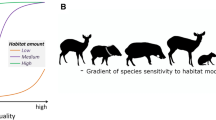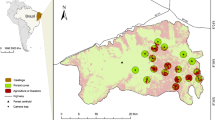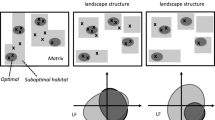Abstract
Context
The classical theory of island biogeography explains loss of species in fragmented landscapes as an effect of remnant patch size and isolation. Recently this has been challenged by the habitat amount and habitat continuum hypotheses, according to which persistence in modified landscapes is related to total habitat amount rather than habitat configuration or the ability of species to use all habitats to varying degrees. Distinguishing between these theories is essential for effective conservation planning in modified landscapes.
Objective
Identify which factors of habitat type, amount and configuration predict the persistence of a keystone woodland specialist, the eastern bettong Bettongia gaimardi, in a fragmented landscape.
Method
In the Midlands region of Tasmania we carried out camera surveys at 62 sites in summer and winter. We included habitat and landscape features to model whether habitat amount or patch size and isolation influenced the presence of the eastern bettong, and to measure effects of habitat quality.
Results
Habitat amount within a 1 km buffer was a better predictor of occupancy than patch size and isolation. Occupancy was also affected by habitat quality, indicated by density of regenerating stems.
Conclusion
Our results support the habitat amount hypothesis as a better predictor of presence. For a species that is able to cross the matrix between remnant patches and utilise multiple patches, the island biogeography concept does not explain habitat use in fragmented landscapes. Our results emphasize the value of small remnant patches for conservation of the eastern bettong, provided those patches are in good condition.


Similar content being viewed by others
References
Algar D, Angus G, Williams M, Mellican A (2007) Influence of bait type, weather and prey abundance on bait uptake by feral cats (Felis catus) on Peron Peninsula, Western Australia. Conserv Sci West Aust 6(1):109
Almeida-Gomes M, Vieira MV, Rocha CFD, Metzger JP, De Coster G (2016) Patch size matters for amphibians in tropical fragmented landscapes. Biol Conserv 195:89–96
Andersen GE, Johnson CN, Barmuta LA, Jones ME (2017) Dietary partitioning of Australia’s two marsupial hypercarnivores, the Tasmanian devil and the spotted-tailed quoll, across their shared distributional range. PLoS ONE 12(11):e0188529
Anderson J, Rowcliffe JM, Cowlishaw G (2007) Does the matrix matter? A forest primate in a complex agricultural landscape. Biol Conserv 135(2):212–222
Ascensão F, Lucas PS, Costa A, Bager A (2017) The effect of roads on edge permeability and movement patterns for small mammals: a case study with Montane Akodont. Landscape Ecol 32(4):781–790
Bailey TG (2012) Eucalypt regeneration and ecological restoration of remnant woodlands in Tasmania. University of Tasmania, Australia
Battin J (2004) When good animals love bad habitats: ecological traps and the conservation of animal populations. Conserv Biol 18(6):1482–1491
Belcher CA, Nelson JL, Darrant JP (2007) Diet of the tiger quoll (Dasyurus maculatus) in south-eastern Australia. Aust J Zool 55(2):117–122
Bennett AF (1990) Habitat corridors and the conservation of small mammals in a fragmented forest environment. Landscape Ecol 4(2):109–122
Bullock JM, Moy I, Pywell RF, Coulson SJ, Nolan AM, Caswell H (2002) Plant dispersal and colonization processes at local and landscape scales. In: Bullock JM, Kenward R, Hails R (eds) Dispersal ecology. Blackwell Scientific, Malden, pp 279–302
Chandler R, King D (2011) Habitat quality and habitat selection of golden-winged warblers in Costa Rica: an application of hierarchical models for open populations. J Appl Ecol 48(4):1038–1047
D’Amico M, Román J, De los Reyes L, Revilla E (2015) Vertebrate road-kill patterns in Mediterranean habitats: who, when and where. Biol Conserv 191:234–242
Ditmer MA, Garshelis DL, Noyce KV, Laske TG, Iaizzo PA, Burk TE, Fieberg JR (2015) Behavioral and physiological responses of American black bears to landscape features within an agricultural region. Ecosphere 6(3):1–21
Doherty TS, Dickman CR, Johnson CN, Legge SM, Ritchie EG, Woinarski JCZ (2017) Impacts and management of feral cats Felis catus in Australia. Mamm Rev 47(2):83–97
Doherty TS, Driscoll DA (2018) Coupling movement and landscape ecology for animal conservation in production landscapes. Proc R Soc B 285:20172272
Eldridge DJ, Woodhouse JN, Curlevski NJA, Hayward M, Brown MV, Neilan BA (2015) Soil-foraging animals alter the composition and co-occurrence of microbial communities in a desert shrubland. ISME J 9:2671
Evju M, Sverdrup-Thygeson A (2016) Spatial configuration matters: a test of the habitat amount hypothesis for plants in calcareous grasslands. Landscape Ecol 31(9):1891–1902
Fahrig L (2002) Effect of habitat fragmentation on the extinction threshold: a synthesis. Ecol Appl 12(2):346–353
Fahrig L (2007) Non-optimal animal movement in human-altered landscapes. Funct Ecol 21(6):1003–1015
Fahrig L (2013) Rethinking patch size and isolation effects: the habitat amount hypothesis. J Biogeogr 40(9):1649–1663
Fahrig L (2017) Ecological responses to habitat fragmentation per se. Annu Rev Ecol Evol Syst 48(1):1–23
Fattebert J, Baubet E, Slotow R, Fischer C (2017) Landscape effects on wild boar home range size under contrasting harvest regimes in a human-dominated agro-ecosystem. Eur J Wildl Res 63(2):32
Fischer Lindenmayer (2007) Landscape modification and habitat fragmentation: a synthesis. Glob Ecol Biogeogr 16(3):265–280
Fischer J, Lindenmayer DB, Barry S, Flowers E (2005) Lizard distribution patterns in the Tumut fragmentation “Natural Experiment” in south-eastern Australia. Biol Conserv 123(3):301–315
Fischer J, Lindenmayer DB, Kaitala V (2006) Beyond fragmentation: the continuum model for fauna research and conservation in human-modified landscapes. Oikos 112(2):473–480
Fiske I, Chandler R (2011) Unmarked: an R package for fitting hierarchical models of wildlife occurrence and abundance. J Stat Softw 43(10):1–23
Fleming PA, Anderson H, Prendergast AS, Bretz MR, Valentine LE, Hardy GES (2014) Is the loss of australian digging mammals contributing to a deterioration in ecosystem function? Mamm Rev 44(2):94–108
Gastón A, Blázquez-Cabrera S, Garrote G, Mateo-Sánchez MC, Beier P, Simón MA, Saura S (2016) Response to agriculture by a woodland species depends on cover type and behavioural state: insights from resident and dispersing Iberian lynx. J Appl Ecol 53(3):814–824
Ghazoul J (2005) Pollen and seed dispersal among dispersed plants. Biol Rev 80(3):413–443
Haddad NM, Brudvig LA, Clobert J, Davies KF, Gonzalez A, Holt RD, Cook WM (2015) Habitat fragmentation and its lasting impact on Earth’s ecosystems. Sci Adv 1(2):e1500052
Haddad NM, Gonzalez A, Brudvig LA, Burt MA, Levey DJ, Damschen EI (2017) Experimental evidence does not support the habitat amount hypothesis. Ecography 40(1):48–55
Haila Y (2002) A conceptual genealogy of fragmentation research: from island biogeography to landscape ecology. Ecol Appl 12(2):321–334
Hanski I (2015) Habitat fragmentation and species richness. J Biogeogr 42(5):989–993
Johnson C (1994a) Distribution of feeding activity of the Tasmanian bettong (Bettongia gaimardi) in relation to vegetation patterns. Wildl Res 21(3):249–255
Johnson CN (1994b) Nutritional ecology of a mycophagous marsupial in relation to production of hypogeous fungi. Ecology 75(7):2015–2021
Johnson C (2006) Australia’s mammal extinctions: a 50000 year history. Cambridge University Press, Cambridge
Johnston CA (2013) Wetland losses due to row crop expansion in the Dakota Prairie Pothole Region. Wetlands 33(1):175–182
Jones ME, Barmuta LA (1998) Diet overlap and relative abundance of sympatric dasyurid carnivores: a hypothesis of competition. J Anim Ecol 67(3):410–421
Jones ME, Davidson N (2016) Applying an animal-centric approach to improve ecological restoration. Restor Ecol 24(6):836–842
Kehoe L, Romero-Muñoz A, Polaina E, Estes L, Kreft H, Kuemmerle T (2017) Biodiversity at risk under future cropland expansion and intensification. Nat Ecol Evol 1(8):1129
Krauss J, Klein A-M, Steffan-Dewenter I, Tscharntke T (2004) Effects of habitat area, isolation, and landscape diversity on plant species richness of calcareous grasslands. Biodivers Conserv 13(8):1427–1439
Laurance WF (2008) Theory meets reality: how habitat fragmentation research has transcended island biogeographic theory. Biol Conserv 141(7):1731–1744
Laurance WF, Sayer J, Cassman KG (2014) Agricultural expansion and its impacts on tropical nature. Trends Ecol Evol 29(2):107–116
Lazenby BT, Tobler MW, Brown WE, Hawkins CE, Hocking GJ, Hume F, Thalmann S (2018) Density trends and demographic signals uncover the long-term impact of transmissible cancer in Tasmanian devils. J Appl Ecol 55(3):1368–1379
Lindenmayer DB, Fischer J (2013) Habitat fragmentation and landscape change: an ecological and conservation synthesis. Island Press, Washington, DC
Lindgren JP, Cousins SAO (2017) Island biogeography theory outweighs habitat amount hypothesis in predicting plant species richness in small grassland remnants. Landsc Ecol 32:1895–1906
MacKenzie DI, Nichols JD, Hines JE, Knutson MG, Franklin AB (2003) Estimating site occupancy, colonization, and local extinction when a species is detected imperfectly. Ecology 84:2200–2207
Magioli M, Ribeiro MC, Ferraz KMPMB, Rodrigues MG (2015) Thresholds in the relationship between functional diversity and patch size for mammals in the Brazilian Atlantic Forest. Anim Conserv 18(6):499–511
Martinson HM, Fagan WF (2014) Trophic disruption: a meta-analysis of how habitat fragmentation affects resource consumption in terrestrial arthropod systems. Ecol Lett 17(9):1178–1189
Maxwell SL, Fuller RA, Brooks TM, Watson JE (2016) Biodiversity: the ravages of guns, nets and bulldozers. Nature 536(7615):143–145
Mazerolle MJ, Mazerolle MMJ (2017) Package ‘AICcmodavg’
Melo GL, Sponchiado J, Cáceres NC, Fahrig L (2017) Testing the habitat amount hypothesis for South American small mammals. Biol Conserv 209:304–314
Mönkkönen M, Rajasärkkä A, Lampila P (2014) Isolation, patch size and matrix effects on bird assemblages in forest reserves. Biodivers Conserv 23(13):3287–3300
Mortelliti A, Amori G, Boitani L (2010) The role of habitat quality in fragmented landscapes: a conceptual overview and prospectus for future research. Oecologia 163(2):535–547
Munguía-Rosas MA, Montiel S (2014) Patch size and isolation predict plant species density in a naturally fragmented forest. PLoS ONE 9(10):e111742
Newbold T, Hudson LN, Hill SL, Contu S, Lysenko I, Senior RA, Day J (2015) Global effects of land use on local terrestrial biodiversity. Nature 520(7545):45
Pemberton D, Gales S, Bauer B, Gales R, Lazenby B, Medlock K (2008) The diet of the Tasmanian devil, Sarcophilus harrisii, as determined from analysis of scat and stomach contents. In: Papers and Proceedings of the Royal Society of Tasmania, vol 142, pp. 13–22
Püttker T, Bueno AA, De Barros CD, Sommer S, De Pardini R (2011) Immigration rates in fragmented landscapes—empirical evidence for the importance of habitat amount for species persistence. PLoS ONE 6(11):e27963
Ripperger SP, Kalko EK, Rodríguez-Herrera B, Mayer F, Tschapka M (2015) Frugivorous bats maintain functional habitat connectivity in agricultural landscapes but rely strongly on natural forest fragments. PLoS ONE 10(4):e0120535
Ruiz-Capillas P, Mata C, Malo JE (2015) How many rodents die on the road? Biological and methodological implications from a small mammals’ roadkill assessment on a Spanish motorway. Ecol Res 30(3):417–427
Sahlin E, Schroeder LM (2010) Importance of habitat patch size for occupancy and density of aspen-associated saproxylic beetles. Biodivers Conserv 19(5):1325–1339
Sarre SD, MacDonald AJ, Barclay C, Saunders GR, Ramsey DSL (2013) Foxes are now widespread in Tasmania: DNA detection defines the distribution of this rare but invasive carnivore. J Appl Ecol 50(2):459–468
Seahra SE, Yurkonis KA, Newman JA (2016) Species patch size at seeding affects diversity and productivity responses in establishing grasslands. J Ecol 104(2):479–486
Seibold S, Bässler C, Brandl R, Fahrig L, Förster B, Heurich M, Müller J (2017) An experimental test of the habitat-amount hypothesis for saproxylic beetles in a forested region. Ecology 98(6):1613–1622
Sodhi NS, Ehrlich PR (2010) Conservation biology for all. Oxford University Press, Oxford
Spencer PBS, Yurchenko AA, David VA, Scott R, Koepfli KP, Driscoll C, O’brien SJ, Menotti-Raymond M (2016) The population origins and expansion of feral cats in Australia. J Hered 107(2):104–114
Taylor RJ (1992) Distribution and abundance of fungal sporocarps and diggings of the Tasmanian bettong, Bettongia gaimardi. Aust J Ecol 17(2):155–160
Taylor RJ (1993a) Habitat requirements of the Tasmanian bettong (Bettongia gaimardi), a mycophagous marsupial. Wildl Res 20(5):699–710
Taylor RJ (1993b) Home range, nest use and activity of the Tasmanian bettong, Bettongia gaimardi. Wildl Res 20(1):87–95
Tittensor DP, Walpole M, Hill SL, Boyce DG, Britten GL, Burgess ND, Baumung R (2014) A mid-term analysis of progress toward international biodiversity targets. Science 346(6206):241–244
Torrenta R, Villard MA (2017) A test of the habitat amount hypothesis as an explanation for the species richness of forest bird assemblages. J Biogeogr 44:1791–1801
Venter O, Sanderson EW, Magrach A, Allan JR, Beher J, Jones KR, Levy MA (2016) Sixteen years of change in the global terrestrial human footprint and implications for biodiversity conservation. Nat Commun 7:12558
Woinarski JCZ, Risler J, Kean L (2004) Response of vegetation and vertebrate fauna to 23 years of fire exclusion in a tropical Eucalyptus open forest, Northern Territory, Australia. Aust Ecol 29(2):156–176
Acknowledgements
We thank Greening Austral Tasmania Inc. (GA), Bush Heritage Australia (BHA), Tasmania Land Conservancy (TLC) and the Tasmanian Department of Primary Industry, Parks, Water and Environment (DPIPWE) for helping with appropriate contacts and guidance in selecting sampling sites. In particular, we would like to thank Neil Davidson and Sebastian Burgess (GA) for working closely with us on the ecological restoration project in the Midlands, Matt Appleby (BHA) for his extensive help and knowledge of the Midlands, and Oberon Carter (DPIPWE) for running the GIS-based site selection algorithm. The project was funded by an Australian Research Council (ARC) Linkage Scheme grant (LP130100949). Christopher Johnson was supported on an ARC Australian Professorial Fellowship and Menna Jones on an ARC Future Fellowship (FT100100031). Thanks to the Holsworth Research Endowment for providing crucial funding for covering fieldwork costs. Greatest acknowledgements to PhD students: Rowena Hamer, Glen Bain, and Mauel Ruiz for aiding in fieldwork. Finally. Dr. Peter Gardiner for an outsider’s perspective and to the reviewers and editor for comments contributing to the completion of the manuscript.
Author information
Authors and Affiliations
Contributions
RG, MJ, CJ, and RH conceived the ideas and designed methodology. RG and RH collected and analysed the data. RG, CJ and MJ wrote the manuscript. All authors contributed to the final approval for publication.
Corresponding author
Electronic supplementary material
Below is the link to the electronic supplementary material.
Rights and permissions
About this article
Cite this article
Gardiner, R., Bain, G., Hamer, R. et al. Habitat amount and quality, not patch size, determine persistence of a woodland-dependent mammal in an agricultural landscape. Landscape Ecol 33, 1837–1849 (2018). https://doi.org/10.1007/s10980-018-0722-0
Received:
Accepted:
Published:
Issue Date:
DOI: https://doi.org/10.1007/s10980-018-0722-0




